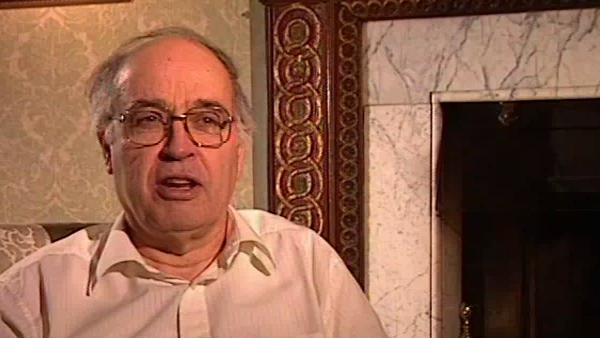NEXT STORY

Evolving story of instantons
RELATED STORIES

NEXT STORY

Evolving story of instantons
RELATED STORIES


|
Views | Duration | |
|---|---|---|---|
| 61. Lacunas and hyperbolic equations | 551 | 04:01 | |
| 62. Further research on lacunas | 443 | 02:36 | |
| 63. Instanton | 1 | 628 | 03:25 |
| 64. Evolving story of instantons | 528 | 02:38 | |
| 65. Almost beaten by Manin | 929 | 01:31 | |
| 66. Euclidian version of twistor theory | 636 | 02:08 | |
| 67. Collaborating with physicists | 1239 | 02:08 | |
| 68. The lack of a background in physics | 1 | 1229 | 02:02 |
| 69. Three manifold invariants | 790 | 02:55 | |
| 70. Individual contributions | 675 | 01:02 |


I'd heard from Roger Penrose that he'd been to some meeting and there were these things called instantons, but that was fine. And then Singer came, I think he even wrote to me before he came, saying, ‘I'm sure you'll be interested in these, work with the physicists and they have these equations called the Yang–Mills equations, and there are the first order equations, there are second order equations which I think, you know, you will find interesting’. And then he came and... and told us about them and we picked them up and... and learnt it. So I... I think certainly he'd... he’d talked with the physicists. He was very well connected through... through Chern on the one hand, and Chern talked a bit with Yang and... and… so he'd... he’d picked up quite a lot from there. And so certainly he was the one who brought... brought it to Oxford and... and so then we started working on understanding the... the geometrical meaning of the self-duality equations and... and the Yang–Mills equations. And of course at the same time Roger Penrose's group and Richard Ward were... were looking at it from their point of view with the twistor... twistor interpretation, you know, alongside.
So I'm not sure, you know, whether they… to what extent Richard [sic] Ward was influenced by Singer coming in. He probably was. I mean, but... but for the physicists, the Yang–Mills equations were... were in the air and Roger Penrose, as I say, his group would have known about these because they knew about corresponding things in... in gravitational theory, and so I think it may have been somewhat... somewhat independent but converging in the Oxford context. So that's how it started and of course that led on to a sort of long-term involvement of collaboration with lots of people. And Roger Penrose's group and yourself and Singer and many other people over many, many, many years in a way. So it… it was again, I think a fruitful combination of Penrose being there, we'd already established the dialogue with the twistor theory and the sheaf cohomology which gave a kind of natural launching pad. When... when this problem arose we were all ready in some sense, the technique was all there and we just had to understand what the equations were.
But... but I remember when... when Richard Ward explained his... his approach to the self-dual equations, because that was the case where I… there was this famous seminar he gave which I... I sort of, I half thought about going to it and half thought of not bothering, and at the last minute I decided I'd go. You know, you go to a lot of seminars and I suppose 90% of the time you get something out of them and sometimes it's a bit boring, but every now and again something really interesting happens. And that was the case with this seminar of Richard Ward's, and I went along not expecting anything much, didn't quite know what he was going to talk about, and clearly by the end of the seminar I... I was really sort of terribly excited by what I had heard. And I wanted to understand it in my own language. And then I went away and spent a hard weekend trying to explain… follow it through the implications and convert it back. And then I saw that… how one could use it for getting global solutions in the four-sphere and things, and then I went back and told Roger Penrose's group and so on. But it was, you know, if I hadn't gone to that seminar, that particular… well, something might have happened later on, but not... not that way, and... and it was again a question of the opportunity.
Eminent British mathematician Sir Michael Atiyah (1929-2019) broke new ground in geometry and topology with his proof of the Atiyah-Singer Index Theorem in the 1960s. This proof led to new branches of mathematics being developed, including those needed to understand emerging theories like supergravity and string theory.
Title: Instanton
Listeners: Nigel Hitchin
Professor Nigel Hitchin, FRS, is the Rouse Ball Professor of Mathematics and Fellow of Gonville and Caius College, Cambridge, since 1994, and was appointed to the Savilian Professorship of Geometry in October 1997. He was made a Fellow of the Royal Society in 1991 and from 1994 until 1996 was President of the London Mathematical Society.
His research interests are in differential and algebraic geometry and its relationship with the equations of mathematical physics. He is particularly known for his work on instantons, magnetic monopoles, and integrable systems. In addition to numerous articles in academic journals, he has published "Monopoles, Minimal Surfaces and Algebraic Curves" (Presses de l'Universite de Montreal, 1987) and "The Geometry and Dynamics of Magnetic Monopoles" (Princeton University Press, 1988, with Michael Atiyah).
Tags: Roger Penrose, Isadore Singer, Shiing-Shen Chern, Richard Ward
Duration: 3 minutes, 26 seconds
Date story recorded: March 1997
Date story went live: 24 January 2008